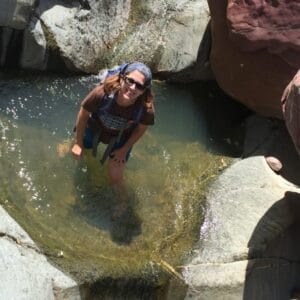
In this series, we’re sitting down with the Swette Center-affiliated faculty to catch up on food systems, innovation, and what makes a good meal. See the rest of the series on our Food Systems Profiles page.
Read on for an interview with Michelle Stewart, Senior Global Futures Scientist and Instructor in the School of Sustainability.
1) How did you get interested in food systems issues?
Like many others, I was first drawn to food systems as a child playing outside in fields on a small barrier island in south Texas. Growing up, we had a vibrant garden that awakened my curiosity about the world around me. It wasn’t until college, when I was introduced to writers like Aldo Leopold and Wendell Berry and their articulation of the intrinsic and timeless value of all elements of our natural world that I began to more fully grasp how my own connection to the land (and water) was an anchor that many of us humans have in common. After my undergraduate degree, I taught public school for a few years in a rural area, where we relied on our garden to produce most of our food. That experience deepened my relationship with the soil and taught me the profound connection between nurturing the land and enjoying a satisfying meal. This personal journey eventually shaped my graduate academic pursuits. My interest in food systems all began with an appreciation for place and the realization that the land plays an integral role in our lives through the food we consume. I know many people share a similar story of falling in love with the land and where their food comes from, so I like to think of food, soil and water as holding inherent potential to unlock connections and awareness.
2) Share a glimpse of your current research and how it applies to food systems transformation.
Currently, my research revolves around the intricate relationship between food, energy, and water in urban contexts, with a particular emphasis on education and practical applications. One of my main teaching focal points is sustainable urban dynamics, where we delve into the complexities of urban systems and their interactions. I encourage exploring practical questions that arise from the convergence of these systems as part of my work to raise awareness and encourage curiosity. Additionally, my research explores the security aspects of food, energy, and water systems, examining when and where these issues are being addressed and by and for whom. These inquiries lead to work focused on justice and equity. In terms of teaching and research, my focus extends beyond Phoenix to urban settings in general. On a personal level, I’m eager to reconnect with my gardening roots, a passion that originated in Texas and continues today. While I haven’t fully revived that practice, I make an effort to visit urban agriculture initiatives like Project Roots in South Phoenix to learn from others and contribute where I can.
My academic journey has led me to address complex sustainability challenges such as climate change, food security, and the intricate food-energy-water nexus. During my graduate studies, I focused on conserving rare ecosystems, particularly the coastal prairie of southern Texas. This region is home to several endangered plant species, and my fieldwork aimed to understand threats to specific species and their ecological dependencies and policy connections. As a geographer, my path to sustainability began with questions about ‘why is what where?.’ My previous research has mainly centered on the conservation of biological diversity and ecological restoration efforts. It’s fascinating to explore the nuances and multiple meanings that these subjects hold, especially when it comes to sustainability and the complex issue of restoration—what we’re restoring, to what extent, and through which historical lens.
3) What’s an innovation in the food systems world that you’re excited about?
I’m genuinely excited about the growing emphasis on regenerative agriculture and, in particular, the pioneering work of the Land Institute in Kansas. They’ve been at the forefront of ecological intensification and the development of perennial polycultures. A standout example is Kernza, a perennial grain that’s gaining traction. You can even find Kernza in products like the beer at Wilderness Brewery. It’s thrilling to witness its expanding impact on a broader scale. I’ve admired the Land Institute’s work for a long time, and I’m still enthusiastic about their ongoing initiatives.
Another area that holds promise relates to appreciating the unique attributes of a place and what it demands of us in terms of learning and contribution. Recently, I’ve been intrigued by the resurgence of heirloom crop varieties. It’s heartening to see the diversity within these crops, which contrasts with the limited choices we often have today. For instance, I came across a project in India that catalogs numerous indigenous rice varieties in regions like Goa. There in Goa, for example, an impressive 28 different indigenous rice varieties exist. One variety, ‘Korgut,’ is gaining recognition. This trend highlights the potential of local and indigenous knowledge to guide innovations in sustainable food systems. Remarkably, many of these rice varieties in Goa are salt-tolerant and can thrive in saltwater conditions.
4) What’s your favorite weeknight meal?
My favorite weeknight meal is when my husband cooks. It’s a treat when he prepares his homemade pasta. He carefully makes the pasta dough, rolls it out, and tops it with a vibrant red homemade sauce. The sauce blends tomato richness with a touch of brightness from vinegar and lemon. Instead of meat in the sauce, he uses tofu, or he might add mushrooms. He pan-fries the tofu with just a hint of oil, giving it a delightful crispiness on the outside, and it’s awesome in the sauce.